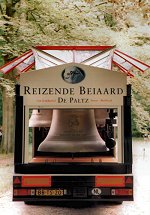
SOEST - The carillon, nowadays known as 'Travelling Carillon De Paltz', came into the possession of Mr. E.S. Raatjes in 1997. Because of the poor condition of the carillon Mr. Raatjes decided to have the impressive instrument restored and improved. With as many as 59 bells the instrument is now the largest and heaviest travelling carillon in the world.
The largest bell of the carillon weighs 2,150 kg and its smallest 8½ kg. The bronze bells alone weigh a total of 10,957 kg. Because of this weight, and also because of the carillon's totally improved and embellished appearance, it was decided that the carillon should be transported using a Mack Super-Liner truck. The home of the carillon is the 'De Paltz' country estate on the Utrecht range of hills in the municipality of Soest (The Netherlands).
FROM AARLE-RIXTEL TO LIBINGEN
The bells of the travelling carillon can already look back at a lifetime of moving house. Their existence starts in 1965 at the Royal Bellfoundry Petit & Fritsen in Aarle-Rixtel (The Netherlands). At the request of Walter Meierhans a 3-octave manually played carillon with 39 bells is designed.
The new carillon is meant for a tower in the small Swiss hamlet of Libingen, which Meierhans has had built especially with this in mind. However, after the installation, the well-to-do Swiss is not really happy. Most music written for the carillon is for 4 octave instruments, which means that only a limited repertoire is possible for the new Libbingen carillon. Therefore the musician decides almost immediately to expand the carillon. Another 8 heavier bells and 12 little treble bells are cast in Aarle-Rixtel. The total number of bells is now 59.
FROM LIBINGEN TO ZÜRICH
Libingen becomes a tourist attraction. Every Saturday and Sunday people pour in from far and wide to listen to the special concerts. At noon throughout the week the automatic bells ring out across Libingen. The carillon, being among the heaviest instruments in Western Europe, more than recovers its costs.
Unfortunately, Walter Meierhans does not get on with the local, mainly agricultural population. When Meierhans' dog is poisoned, he has had enough and decides to leave Libingen and take the bells with him. The carillon is dismantled and moved to Zurich for storage. Meierhans himself goes to France in search of a new accomodation.
FROM ZÜRICH TO CHATEAURENARD
In 1984 Meierhans meets a businessman who knows a castle for sale in Chateaurenard: 'Chateau de la Motte'. Even before the final sale has been settled, Meierhans moves into part of the castle and decides to re-install the carillon.
However, when people from Petit & Fritsen arrive from Aarle-Rixtel, it appeares that the money for buying the castle has not yet arrived and, not surprisingly, the owner refuses Meierhans and company access to the castle. Nevertheless, after some discussion, the lady of the castle agrees with the installation of the carillon, because the bells will give the castle added value.
FROM CHATEAURENARD TO SALAVAUX
Two years later, in 1986, Meierhans finally manages to strike a bargain with the owner of the castle. He is allowed to take the bells with him in exchange for his valuable collection of antiques. The carillon is once again dismantled and taken to the Swiss town of Salavaux where Meierhans has rented the local castle.
And what once happened at Libingen now happens to Salavaux. The sound of the carillon drags the town out of its anonymity and busloads of tourists pour in. This time, however, money becomes a problem. Due to disagreements with his business partners, Meierhans is in 1988 no longer able to meet his commitments. He has to part from his 59 bells to settle his rent arrears. The carillon is again dismantled and taken to Berne.
FROM SALAVAUX TO THE NETHERLANDS
The new owner originally wanted to give the carillon to the city of Berne, he later considers having the carillon installed in his home town Avenches. None of these plans are carried out. Instead Petit & Fritsen from Aarle-Rixtel propose to use the bells for a new travelling carillon which is given the name 'Papageno'.
Soon thereafter the instrument adorns the festivities held in many places in Switzerland to celebrate the country's 700 year old existence. In 1994 the carillon is present during the congress of the World Carillon Federation in Chambéry (France).
In 1997 Mr. Raatjes realizes and supervises the extension and perfection of the carillon in the tower of the St. Martinus church of Weert. In connection with the festivities around this event the travelling carillon 'Papageno' comes over from Switzerland to The Netherlands at the request of Mr. Raatjes. Than Mr. Raatjes learns that the Swiss owner would like to sell the instrument. Following a thorough restoration with numerous additions the instrument gets its new name: 'Travelling Carillon De Paltz', after the estate of Mr. Raatjes.
Eventually, after a long search in America and Canada a suitable truck - the old model Mack Super-Liner - is found and shipped to The Netherlands. Because the truck is worn to shreds it is extensively renovated as well. At that time lots of extra items are added, like rotating platforms with animals above the new built sleeping cabin. The entity is painted in the colours of the country estate.
With Soest as operating base the carillon still travels to all kinds of special (noncommercial) events many times a year!
